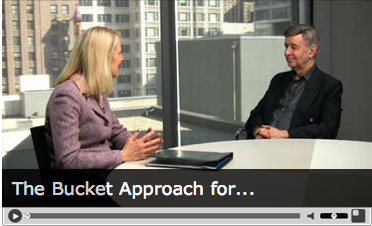This guy makes a big deal of this ‘new approach’ to investing.
Recognizing that people are scared of the market right now [AJC: before they become irrationally exuberant, again, in the next upswing] instead of giving this guy 100% of your money to invest in crappy mutual funds …
… you only give him 80% 😉
You put ‘the other 20%’ into The Bank, so that you have 2 years of cash to live off, and essentially ride the downswings.
I think that they’re hoping that by focusing on that yummy cash, you’ll forget to check what the market is doing, until you next go to top up your 2 year bucket.
OK, pre-retirement, 2 years living expenses is way too much to have aside. $0 is a better number.
Post retirement, I agree on the 2 year number (in fact, I recommend it); but, I don’t agree with his recommendations for the 80% bucket 🙂






I heard something a little different. My take on it was something like this: There was a big crash and people lost a lot of money in 1987 and were forced to eat tuna in basement apartments with bent forks. Then this guy had a great idea. Have enough cash on hand to allow people to keep their house in case it happened again, and enough cash if they were planning on buying a house in the next 5 years. Anything extra goes into the ultra risky, burn you at any time, market. Pfffff. Maybe that’s why his glass window is so big, that’s the other part of his “new” strategy he doesn’t talk about…
If 20% of your money equals two years living expenses, I’d say you have bigger issues than asset allocation and should be putting that money to better use than creating what amounts to a very large unproductive emergency fund.
I agree with the principal of setting aside enough in cash (or other liquid capital protected instruments) to cover your living expenses for sufficiently long to minimise the risk of being forced to sell assets at bad prices BUT if you have reached the point were a diversified portfolio of equities, real estate and other assets produces more income than your living expenses then two years’ worth seems like overkill to me.
Why do you recommend 2 years(post retirement)?
@ Steve – Excellent question! Because in MM301, you may have stopped working / business, therefore, need an extra-wide cushion in case of a real emergency. You probably don’t want to use (or can’t use) any of the $0 Emergency Fund ideas any more.
And, to TraineeInvestor’s point, we are only putting aside 10% of our Number for this (multiply your annual expenses x 20, as part of calculating your number … put 2/20th of this into your Emergency Fund).
Having 10% of your net worth in cash doesn’t sound like a bad idea to me, in retirement 🙂
Adrian, what you said makes sense in most cases I suppose, but ,each case /person will have different circumstances ,even after retirement.Some sort of funds set aside seems a wise move.You cannot fore see very situation that might arise,especially at an advanced age.
Well, as I see it, keeping 20 % in cash is a way to decrease the risk in your investments. Probably a wise thing to do when you’re retired. As Adrian suggested, I guess 10 % could be enough, since you can always decrease the risk in other ways too, by for instance selling stocks and buying bonds instead.
@Investor Trainee, what about hedging a long portfolio with far OTM LEAPS puts on a broad index, like the SPX?
@ Passiivinen Sijoittaja – I was more thinking trading in ‘speculative investments’ for ‘real investments’ such as income-producing real-estate, which is not hard to do … just pay 100% cash!
But, if RE isn’t your thing, then I guess inflation-protected treasury bonds (in USA = TIPS) will do … perhaps, with 5% of your portfolio in 12-month calls over the S&P500, if you want a little spice in your life [courtesy of Zvie Brodie: “Worry Free Retirement” author] 🙂